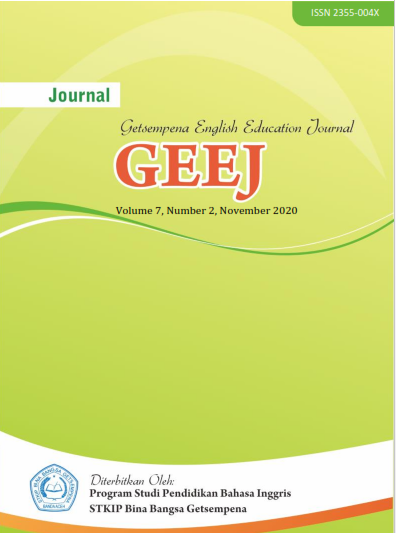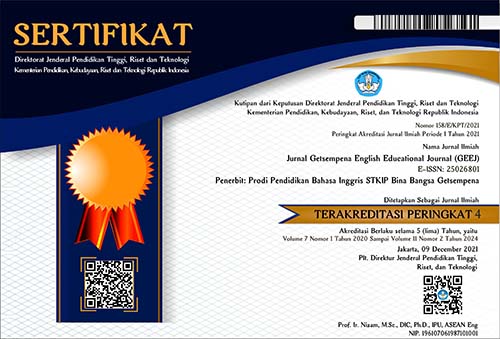ADJECTIVE AND NOUN CLAUSE LEXICAL DENSITY IN AN ENGLISH TEXTBOOK FOR SENIOR HIGH SCHOOL STUDENTS
Abstract
This paper analyzed the lexical density of the adjective and noun clauses in an English textbook for senior high school students in Indonesia. It aimed to discover whether or not the textbook was suitable for the students in terms of lexical density. The researchers employed a content analysis approach to analyze data. There were 116 sentences, containing adjective and noun clauses, which were investigated. The researchers implemented the lexical density theory and the lexical density indicators to determine the average level of the lexical density measurements. Results showed that there were three lexical density levels found in those adjective and noun clauses. The three levels were low, medium, and high. The average level of the lexical density obtained from the adjective and noun clauses in the textbook was 47%, which was categorized as low lexical density. Thus, the researchers concluded that the English textbook for the tenth-grade students published by the Indonesian Government was appropriate for the students.
References
Arvani, M. (2006). A discourse analysis of business letters written by Iranians & native speakers. The Asian ESP Journal, 1(2), 12-23.
Ary, D., Jacob, L.C., & Razavieh, A. (2010). Introduction to research in education (8th ed.). Belmont: Wadsworth Thomson Learning.
Bahrudin, D. V. Y. (2016). The effect of textbook readability on students’ reading comprehension. Wacana Didaktika, 4(1), 42-54.
Berendes, K., Vajjala, S., Meurers, D., Bryant, D., Wagner, W., Chinkina, M., & Trautwein, U. (2018). Reading demands in secondary school: Does the linguistic complexity of textbooks increase with grade level and the academic orientation of the school track?. Journal of Educational Psychology, 110(4), 518.
Camiciottoli, B. C. (2003). Metadiscourse and ESP reading comprehension: An exploratory study. Reading in a foreign language, 15(1), 28.
Dale, D. (1948). The Dale-Chall formula for predicting readability. Educational Research Bulletin, 27, 11-20.
Dale, E., & Chall, J.S. (1995). Readability revisited: The new Dale-Chall readability formula. Cambridge, MA: Brookline Books.
Daller, H., van Hout, R., & Treffers-Daller, J. (2003). Lexical richness in the spontaneous speech of bilinguals. Applied Linguistics, 24(2), 197-222.
Engber, C. A. (1995). The relationship of lexical proficiency to the quality of ESL compositions. Journal of Second Language Writing, 4(2), 139-155.
Gregori-Signes, C., & Clavel-Arroitia, B. (2015). Analysing lexical density and lexical diversity in university students’ written discourse. Procedia-Social and Behavioral Sciences, 198, 546-556.
Gregori-Signes, C., & Clavel-Arroitia, B. (2015). Analysing lexical density and lexical diversity in university students’ written discourse. Procedia-Social and Behavioral Sciences, 198(2015), 546-556.
Hanafiah, R., & Yusuf, M. (2016, November). Lexical density and grammatical intricacy in linguistic thesis abstract: A qualitative content analysis. In Proceedings Of English Education International Conference (Vol. 1, No. 2, pp. 43-46).
Hendrikse, R., & van Zweel, H. (2010). A phylogenetic and cognitive perspective on linguistic complexity. Southern African Linguistics and Applied Language Studies, 28(4), 409-422.
Hsu, W. (2009). College English textbooks for general purposes: A corpus-based analysis of lexical coverage. Electronic Journal of Foreign Language Teaching, 6(1), 42-62.
Huddleston, R. (1984). Introduction to the grammar of English. Cambridge: Cambridge University Press.
Ishikawa, S. I. (2015). Lexical development in L2 English learners’ speeches and writings. Procedia, Social and Behavioural Sciences, 198, 202-210.
Islam, Z., Mehler, A., & Rahman, R. (2012). Text readability classification of textbooks of a low-resource language. In Proceedings of the 26th Pacific Asia Conference on Language, Information, and Computation (pp. 545-553).
Johansson, V. (2008). Lexical diversity and lexical density in speech and writing: A developmental perspective. Working Papers in Linguistics, 53, 61-79.
Karman, K. (2016). Lexical features of senior high school students’ writing on recount text. Journal of English Education, 1(2), 106-110.
Kim, S. S. (2002). A corpus-based analysis of the words in the elementary school English textbooks. English Teaching, 57(3), 253-277.
Konakahara, M. (2011). Analysis of Request Events in English Textbooks for Japanese Secondary Schools. Bulletin of Graduate School of Education, Waseda University, 1(19).
Kondal, B. (2015). Effects of lexical density and lexical variety in language performance and proficiency. International Journal of IT, Engineering and Applied Sciences Research (IJIEASR), 4(10), 25-9.
Koya, T. (2004). Collocation research based on corpora collected from secondary school textbooks in Japan and in the UK. Dialogue, 3, 7-18.
Kwapien, J., Drozdz, S., & Orczyk, A. (2010). Linguistic complexity: English vs. Polish, text vs. corpus. arXiv preprint arXiv:1007.0936.
Lie, A. (2007). Education policy and EFL curriculum in Indonesia: Between the commitment to competence and the quest for higher test scores. TEFLIN Journal, 18(1), 01-15.
Lu, X. (2012). The relationship of lexical richness to the quality of ESL learners’ oral narratives. The Modern Language Journal, 96(2), 190-208.
MacDonald, S. P. (2002). Prose styles, genres, and levels of analysis. Style, 36(4), 618-638.
Miller, D. (2011). ESL reading textbooks vs. university textbooks: Are we giving our students the input they may need?. Journal of English for Academic Purposes, 10(1), 32-46.
Mueller, B. M. (2015). Analysis of nominalization in elementary and middle school science textbooks. School of Education Student Capstones and Dissertations. Paper 247.
Nesia, B. H., & Ginting, S. A. (2014). Lexical density of English reading texts for senior high school. TRANSFORM Journal of English Language Teaching and Learning of FBS UNIMED, 3(2).
Nugraha, A. P., & Fithriyah, N. H. M. P. (2020). Lexical density of reading comprehension material in English textbook pathway to English for senior high school grade xii published by Erlangga (Doctoral dissertation, IAIN Surakarta).
O'Loughlin, K. (1995). Lexical density in candidate output on direct and semi-direct versions of an oral proficiency test. Language testing, 12(2), 217-237.
Perfetti, C. A. (1969). Lexical density and phrase structure depth as variables in sentence retention. Journal of Verbal Learning and Verbal Behavior, 8(6), 719-724.
Pratiwi, Y., Farikah, F., & Indriani, L. (2018). An analysis of lexical density and readability in reading text on English textbook used by form 4 level of secondary school students in SMKBSB Malaysia. Journal of Research on Applied Linguistics, Language, and Language Teaching, 1(1), 66-75.
Presnyakova, I. (2011). Systemic functional analysis of elementary school language arts textbooks. Theses, Dissertations and Capstones. 269. https://mds.marshall.edu/etd/269
Putra, D. A., & Lukmana, I. (2017). Text complexity in senior high school English textbooks: A systemic functional perspective. Indonesian Journal of Applied Linguistics, 7(2), 436-444.
Rahma, A. (2018). Readability levels in the reading texts of pathway to English for 11th grade students of senior high school (Doctoral dissertation, Universitas Brawijaya).
Rimmer, W. (2008). Putting grammatical complexity in context. Literacy, 42(1), 29-35.
Sari, D. (2016). Measuring Quality of Reading Materials in English textbook: The Use of Lexical Density Method in Assessing Complexity of Reading Materials of Indonesia’s Curriculum–13 (K13) english textbook. JOALL (Journal of Applied Linguistics & Literature), 1(2), 30-39.
Schleppegrell, M. J. (2001). Linguistic features of the language of schooling. Linguistics and Education, 12(4), 431-459.
Sholichatun, S. (2011). Content analysis of reading materials in English on Sky Textbook for junior high school. Semarang: IAIN Walisongo.
Šišková, Z. (2012). Lexical richness in EFL students’ narratives. Language Studies Working Papers, 4, 26-36.
Smith, N. F., Wood, L. N., Gillies, R. K., & Perrett, G. (1994). Analysis of student performance in statistics. In Mathematics Education Research Group of Australasia Conference, Lismore.
To, V., & Mahboob, A. (2018). Linguistic complexity in English textbooks: A functional grammar perspective. In Structuring the Thesis (pp. 77-86). Singapore: Springer.
To, V., Fan, S., & Thomas, D. (2013). Lexical density and readability: A case study of English textbooks. Internet Journal of Language, Culture and Society, 37, 61-71.
Ure, J. (1971). Lexical density and register differentiation. Applications of linguistics, 443-452.
Uri, N. F. M., & Abd Aziz, M. S. (2018). Assessing readability of a national exam reading texts in Malaysia. European Journal of English Language Teaching, 4(1), 149-164.
Varzaneh, M. M., & Darani, H. L. (2018). EFL Textbook evaluation: An analysis of readability and vocabulary profiler of Four Corners Book Series. International Journal of Foreign Language Teaching and Research, 6(22), 47-57.
Vera, G. G., Sotomayor, C., Bedwell, P., Domínguez, A. M., & Jéldrez, E. (2016). Analysis of lexical quality and its relation to writing quality for 4th grade, primary school students in Chile. Reading and Writing, 29(7), 1317-1336.
Yetti, D. (2019). An analysis of readability level of reading material in English textbook for first grade of senior high school (Doctoral dissertation, Universitas Islam Negeri Sultan Syarif Kasim Riau).
























